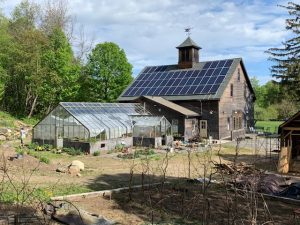 One spinoff of the COVID-19 pandemic – beyond the mad rush on toilet paper – is a spike in puttering around the house, both indoors and out.
One spinoff of the COVID-19 pandemic – beyond the mad rush on toilet paper – is a spike in puttering around the house, both indoors and out.
In addition to a heightened interest in home renovations, an increasing number of people have started gardens – both because they’ve found themselves with more time on their hands at home, and because of a desire to be more self-sufficient when it comes to their food supply.
Growing your own flowers and produce does seem like a no-brainer. Many people find that it’s relatively easy to manage a small garden by themselves or with the help of their kids, the supplies and materials are quite inexpensive, it seems like an environmentally friendly thing to do (as opposed to buying items shipped from hundreds or thousands of miles away), and it helps save money that might otherwise be spent at nurseries and grocery stores.
But because Connecticut has a relatively short growing season, some folks have given thought to ways of extending it – in short, buying or building a greenhouse. And why not? In addition to allowing people to plant and harvest vegetables beyond the normal growing season (we fall into USDA plant hardiness zones 5-7), greenhouse owners can also get an early jump on cultivating flower seedlings that will add color and variety to any home landscape.
Rosemary Aldridge, consulting horticulturist for the Elizabeth Park Conservancy, frequently overhears visitors who pass by the park’s four greenhouses – which are accessible only to Conservancy volunteers and staff members and to City of Hartford personnel.
“People peek in and say how much they’d love to have a greenhouse of their own at home,” she shares. After all, when the park’s thousands of colorful flowers and ornamental bushes bloom during parts of the spring, summer and fall, there is no denying the feeling of peace and harmony that blooms right along with them.
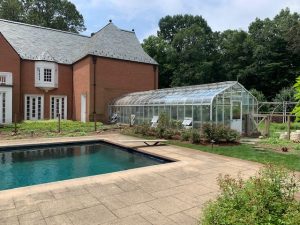 But an informal survey of several homeowners in Connecticut who already have a greenhouse, or have considered it, shows that for the most part, having one in the backyard or attached to the house isn’t always as peaceful or harmonious as it may appear. For better or worse, that’s because of the maintenance and expense involved.
But an informal survey of several homeowners in Connecticut who already have a greenhouse, or have considered it, shows that for the most part, having one in the backyard or attached to the house isn’t always as peaceful or harmonious as it may appear. For better or worse, that’s because of the maintenance and expense involved.
“It’s a wonderful idea to have one, but you must go into it with your eyes open because it’s a huge commitment in time and money,” Aldridge cautions.
To be run properly, greenhouses require constant sources of water, electricity for cooling in the summer and heating in the winter, a solid foundation, fans, a humidifier, window shades and other functional and mostly automatic components – more components, in fact, than most amateurs realize are required.
The greenhouses at Elizabeth Park are magnificent historic structures that date from the 1890s and have no automation. Aldridge is quick to remind anyone who wants to volunteer for the Conservancy that they can do so, and get a first-hand look and feel of what working in a true-blue greenhouse is all about.
Many homeowners who have a greenhouse (while not always of Elizabeth Park vintage, they’re usually from long ago) let their structures remain on their properties even though they rarely, if ever, use them as real greenhouses. In some cases, they’re turned into sunrooms. Why people keep the structures around is often a case of historical pride: there are many greenhouses that are just too beautiful to relinquish. Sometimes, a homeowner will even find a source of financial income, albeit small, to warrant holding onto their distinctive glass shelters.
Richard and Lynne Creed of Farmington check many of those boxes. Richard, who owns a manufacturing company, and Lynne, a retired CPA, have a greenhouse that was built in 1927 on the former Winchell Smith estate on the Farmington River. Their gorgeous greenhouse is a timepiece, a reminder of how much care used to go into the design of such garden centerpieces. But the couple did have to replicate quite a number of components due to the structure’s age. According to Richard, every decision was made with enormous care so that the original architectural and aesthetic character was maintained.
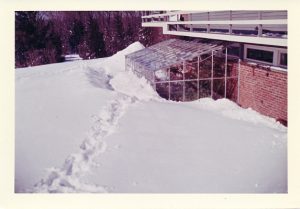 In the old days, Richard explains, greenhouses like his required the full-time care of what were often called “yardmen” who had to attend to them seven days a week.
In the old days, Richard explains, greenhouses like his required the full-time care of what were often called “yardmen” who had to attend to them seven days a week.
“Everyone thinks they would love to own a greenhouse – until they do,” Richard says. He mentions the need to periodically replace the soil, to keep up with pest control, to be vigilant to avoid frozen pipes in the winter, and enough additional responsibilities to make anyone wilt.
“Lynne and I choose our battles wisely in terms of how far to go to sustain our greenhouse in the manner in which it was originally intended. Generally, we use it now primarily in the spring to cultivate very forgiving leafy greens. In truth, these days it’s not much more than a very expensive lawn ornament, and it’s not for the faint of heart.”
One idea that made it just a little more enjoyable recently for the Creeds was when they found a commercial gardener who wanted to use their greenhouse to prepare hundreds of unique flowerpots. The gardener paid a small fee for the privilege, and would have returned to do it again, but she moved to a local farm when her business grew to include crops.
Nora Howard is aware of many Connecticut home greenhouses from the past, including the one she grew up with in Avon, owned by her mother, Elinor Oakes.
“My mom always had flowers in the house, many of which were nurtured in the greenhouse. I never actually worked in it myself – it was totally mom’s thing – but I loved the humidity and the feel of the soil and all the scents of everything growing. It was very special,” she says.
The greenhouse was heated by oil. When oil prices climbed precipitously in the 1970s, Oakes decided to cut back. But Howard remembers it with fondness. While still standing, it is now used only for storage.
Howard’s familiarity with greenhouses has its roots in her work with garden clubs and historical societies. Currently the historian for both the Town of Avon and Avon Congregational Church, she is past president of the Garden Club of Hartford and former director of the Avon and Wethersfield Historical Societies. She has documented several homes that have greenhouses for the Smithsonian Archives of American Gardens.
Howard also has friends with old greenhouses, some of whom gave up on them when the maintenance became too much, and others who, like Richard Creed once did, rent them out. She doesn’t think she could be convinced now to build one of her own, though she most certainly feels a strong connection because of all her research.
It is commonly believed that greenhouses got their start in Italy. Several accounts assert that about 2,060 years ago, the emperor Tiberius was very particular about the fruit for which he yearned, and his minions developed a way to satisfy those anytime/anywhere cravings. The early storage units they built did not look like today’s greenhouses, mostly because they had wheels and were transported like a cart. Despite that, they were often called botanical gardens.
Beginning in the late 16th Century, more conventional-looking greenhouses started to appear in Holland. Then came France, where they were often called orangeries (for obvious reasons), and soon England joined in, where the structures were far more elaborate and renamed conservatories. One of the first conservatories on our own shores was in Boston when Ben Franklin was a young man about town. George Washington also built a conservatory at Mount Vernon.
Many fashionable Victorian homes in America, particularly those owned by wealthy individuals, had conservatories. Mark Twain had one in his Farmington Avenue home in Hartford. Twain’s, which branches off from his library, is multi-sided with glass walls and a pointed glass roof. The floor is composed of crushed stones. Dozens of hanging and potted plants give it the ambience that many have called an “artificial paradise,” and it is in that paradise where Twain often made believe he was on a safari, with his children as willing and eager playmates.
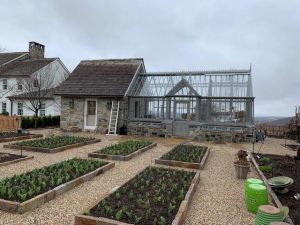 Keeping up a greenhouse today, particularly a freestanding one that requires its own life support system, can be anything but paradise. What’s more, many homeowners go away for extended periods of time, which would leave their greenhouses vulnerable to disorder and disrepair unless they hired someone to take care of them. That’s why greenhouses have ceased to be front and center in Connecticut domestic living.
Keeping up a greenhouse today, particularly a freestanding one that requires its own life support system, can be anything but paradise. What’s more, many homeowners go away for extended periods of time, which would leave their greenhouses vulnerable to disorder and disrepair unless they hired someone to take care of them. That’s why greenhouses have ceased to be front and center in Connecticut domestic living.
Despite all this, Hans van der Spek of J.C. van der Spek Greenhouse Services in Windsor Locks, stays very busy – although it must be noted that the greenhouses he sells and services are massive structures unfit for most suburban homes. In business for more than 35 years, van der Spek says his few residential customers live in or near New York City and Boston. “They’re the kind of people who want to give everything a try,” he concedes, “even something as involved as a greenhouse.”
But van der Spek also adds that more people today, particularly since the pandemic began, are starting to be creative in their home gardens without the use of greenhouses. Many more homeowners, he has noticed, are starting to grow herbs and vegetables for the first time. “Many of us are being more creative in our backyards than ever before,” he says. “Now what’s needed is some more education so that people do it correctly. And we all need to find more time and energy to devote to this very special kind of activity.”
The end result of something like what van der Spek suggests may be three seasons – between April and October – of lush garden delights and sensations all around the state, and one season – between November and March – that perhaps is exactly the way New England winters were always meant to be. For better or worse.
Joel Samberg has landscaped his Avon home with raised beds, walkways and bordered gardens using only materials found around the property, which he says is a great option, given today’s cost of living.


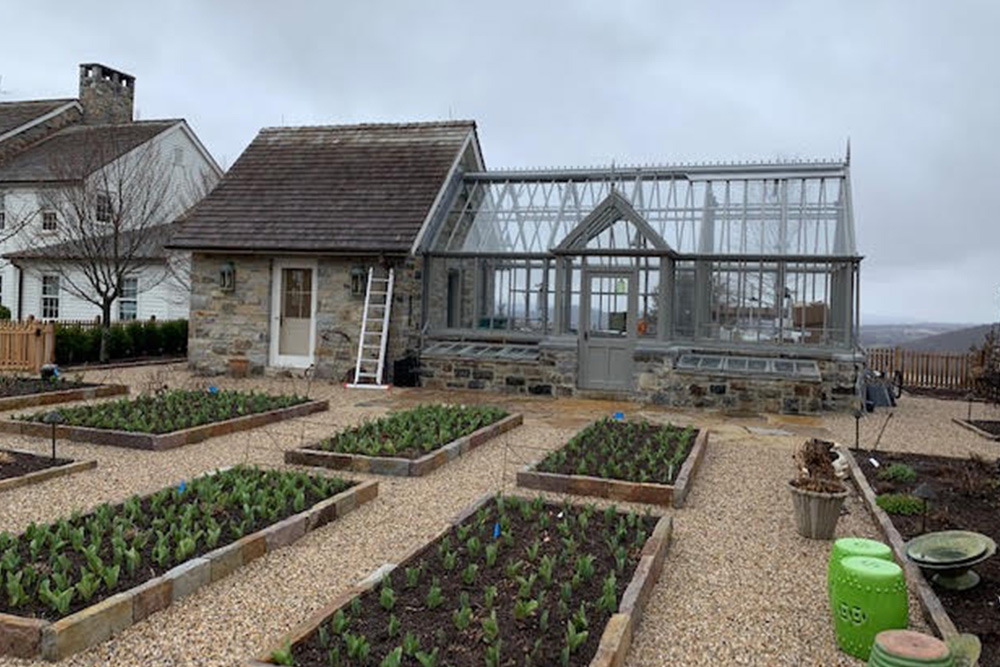



More Stories
Happy Senior Hour for the Holidays
At Home With Kerri-Lee
A New, Free Peabody Museum Prepares for Opening